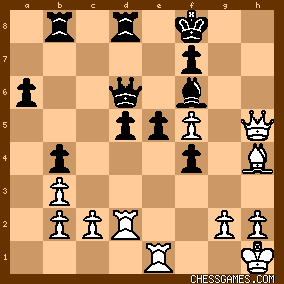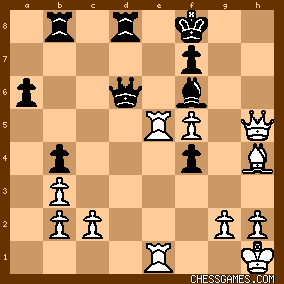|
< Earlier Kibitzing · PAGE 2 OF 2 ·
Later Kibitzing> |
Oct-13-16
 | | An Englishman: Good Evening: Thanks to 3.d4?! (3.c3 or 3.c4), Black equalized easily and might even have stood better at one point. According to the database, Black usually wins after 4...e5 (W8, B25, D10). So this represents quite an impressive comeback for Penrose. If 32...Qxd5; 33.Bxf6,Ke8; 34.Rxe5+,Qxe5; 35.Bxe5 and White wins only because the Queen guards d1. |
|
| Oct-13-16 | | patzer2: Black's error 31...Qd6? sets up today's Thursday solution 32. Rxd5! for a decisive, attacking exchange sacrifice. If 32... Qxd5, then White wins after 33. Bxf6 Ke8 34. Rxe5+ Qxe5 35. Bxe5 Rb5 36. Qh8+ Kd7 37. Qf6 Ke8 38. Bd6 Rxd6 39. Qxd6  (+9.55 @ 22 depth, Deep Fritz 15). (+9.55 @ 22 depth, Deep Fritz 15). Instead of 31...Qd6?, Black can prolong the game with 31...Kg7 32. Rde2  (+1.22 @ 23 depth, Deep Fritz 15) with practical drawing chances. (+1.22 @ 23 depth, Deep Fritz 15) with practical drawing chances. For an early improvement, Black can hold it level with 15... Nxb3 16. axb3 Qb6+ 17. Bf2 Qc6 18. Qe2 Rac8 = (0.03 @ 20 depth, Deep Fritz 15). |
|
| Oct-13-16 | | agb2002: The material is identical.
The black queen is overworked protecting the pawn on d5 and the bishop. Therefore, 32.Rxd5: A) 32... Qxd5 33.Bxf6 Ke8 34.Rxe5+ Qxe5 35.Bxe5 + - [Q+B+2P vs 2R] (35... Rd1+ 36.Qxd1). B) 32... Qb6 33.Qh6+
B.1) 33... Bg7 34.Qxb6 Rxb6 35.Rxd8#.
B.2) 33... Ke7 34.Rxe5+ Qe6 35.Bxf6+ Ke8 36.Qh8#. B.3) 33... Ke8 34.Rexe5+
B.3.a) 34... Bxe5 35.Rxe5+ Kd7 (35... Qe6 36.fxe5 Rd1+ 37.Re1 wins) 36.Rd5+ B.3.a.i) 36... Kc7 37.Bxd8+ Rxd8 38.Qxb6+ Kxb6 39.Rxd8 + - [R+3P]. B.3.a.ii) 36... Ke8 37.Qh8#.
B.3.a.iii) 36... Kc8 37.Rxd8+ Kc7 (37... Kb7 38.Rxb8+ Kxb8 39.Qxb6+ wins) 38.Qxf4+ wins. B.3.b) 34... Kd7 35.B(Q)xf6 + - [B+2P].
B.4) 33... Kg8 34.Bxf6 Qxf6 35.Qxf6 Rxd5 36.Qh8+ Ke7 37.Qxb8 etc. C) 32... Qc6 33.Qh6+ as in B.
D) 32... Qc7 33.Bxf6 Ke8 34.Qh8#.
E) 32... Qe7 33.Qh6+
E.1) 33... Bg7 34.Bxe7+ wins.
E.2) 33... Ke8 34.Bxf6 wins.
E.3) 33... Kg8 34.Bxf6 wins. |
|
| Oct-13-16 | | YouRang: Thursday 32.?

click for larger view
I saw pretty readily that if the black queen were not defending Bf6, that white would play Bxf6, and before long black's king would be swarmed by my Q, B and R. So <32.Rxd5!>

click for larger view
Threatening the Q, but really threatening the K if black allows me to take the lynch-pin Bf6. So, I expected black to try <32...Qe7 33.Rdxe5> again attacking the black queen, whose only move to save the queen and guard the bishop is <33...Qd6>

click for larger view
What I like here is <34.Re6!>, threatening the Q and bishop anyway. Taking the rook with the pawn blocks the defense of Bf6, hence <34...fxe6 35.Bxf6>

click for larger view
Pretty soon white's queen, bishop rook and f-pawn will sack the black king, while black's two rook do little more than get in the way. |
|
| Oct-13-16 | | saturn2: Rxd5
If black retakes he gets into a heavy attack after Bf6. Otherwise Black has lost a pawn and the rook on d5 is on an open file. At this point I stopped already. |
|
| Oct-13-16 | | Abdel Irada: ∞
<<+> Better Prelate Than Never <+>> White wins a pawn with initiative after
<<+> 32. Rxd5! ... > Here Black is best advised to retreat with 32. ...Qc6/b6, so as to maintain the defense of his very important bishop on f6. The consequences for accepting the exchange offer are too unpleasant. < 32. ... Qxd5?
33. Bxf6, Ke8
34. Rxe5+  > >
White comes out with queen, bishop and pawn for two rooks, and given the exposure of the black king, he should win trivially. But even with the queen retreat, Black remains clearly worse: He's a pawn down and his king is not comfortable. ∞ |
|
| Oct-13-16 | | Lambda: This only really requires Monday or Tuesday level calculation. You don't need to see much to be certain that 32. Rxd5 is a good move which improves white's position. When you've calculated that, it's time to wait for black to choose a response. |
|
| Oct-13-16 | | cocker: 17-y-o Penrose versus 63-y-o Tartakower. |
|
| Oct-13-16 | | saturn2: Another idea wins a pawn (if i see it right):
32 Qh6+
a..Ke7 Qxf4
b..Bg7 33 QxQ RxQ 34 f6 followed by Rxe5 |
|
| Oct-13-16 | | ventricule: I went for 33.Qh6+ which seems stronger to me (and Stockfish agrees) |
|
| Oct-13-16 | | PhilFeeley: <ventricule: I went for 33.Qh6+ which seems stronger to me (and Stockfish agrees)> But what do you both do after 33. Bg7? |
|
| Oct-13-16 | | saturn2: <PhilFeeley> I dealt with the answer Bg7 in my post. |
|
Oct-13-16
 | | Willber G: <ventricule: I went for 33.Qh6+ which seems stronger to me> Me too.
<PhilFeeley: But what do you both do after 33. Bg7?> 34. Qxb6 Rxb6
35. Rxd8# |
|
| Oct-13-16 | | Cheapo by the Dozen: <PhilFeeley>,
Exchanging queens at that point seems to win heavy material. |
|
| Oct-13-16 | | thegoodanarchist: Initially I was surprised to see Penrose defeating Tartakower. Then I noticed the date - 1950. ST was passed his prime, at age 61 or 62, and would be dead fewer than 6 years later. And Penrose, not quite 17 at the time of this game, appears to be something of a prodigy. He defeated Golombek the same year. Also quite the family pedigree for the Penroses! Brother Rog is a well-known physicist. Oh the things one can learn @ cg.com :) |
|
| Oct-13-16 | | 1.e4effort: Got this one - as it was in keeping with this week's theme of rook sacs and bishop combos. Nice finish for Penrose |
|
Oct-13-16
 | | Willber G: <Cheapo by the Dozen: <PhilFeeley>, Exchanging queens at that point seems to win heavy material.> It's not an exchange, it's loss of the queen or immediate mate. |
|
| Oct-13-16 | | dufferps: Nice when GMs play it to the end - even when the forced winning line is quite obvious - gives us stuggling players a chance to check our game skills. |
|
| Oct-13-16 | | drollere: the deflecting move Rxd5 jumps out immediately, pretty easy for a thursday. the subsequent Rxe5, and the fact that black never gets a check on the cornered white K, shows how little real defense there is around the black K. tartakower was a gentleman to let kid penrose play it to the end. reminds me of donald byrne's similar courtesy to young bobby fischer. |
|
| Oct-13-16 | | kevin86: After the rook sac, Penrose looked drained. |
|
Oct-13-16
 | | fm avari viraf: A Rose for Tartakower! |
|
| Oct-13-16 | | izimbra: Interesting to go through this game with an engine...Tartakower is bigger name in chess than Penrose, yet in the game, he get's positionally crushed, not being patient enough to nurse the thematic weakness of his backward d-pawn. |
|
Oct-13-16
 | | Pawn and Two: Houdini 3 indicates a better drawing chance for Black at move 21 with: (.56) (28 ply) 21...d5! 22.exd5 Be7 23.Qd2 Bc5 24.Ng4 Kf8 25.Nxh6 f6 26.Ng4 Rxd5. A few moves later, Houdini indicates White had strong winning chances with: (1.66) (25 ply) 29.Rxa6! Ke8 30.g3 fxg3 31.hxg3 Bg7 32.Qf3. The top scorers at Southsea 1950:
Bisguier 7 1/2 (+6 -1 =3)
Tartakower 7 1/2 (+6 -1 =3)
Golombek 7 (+5 -1 =4)
Penrose 7 (+5 -1 =4)
L. Schmid 7 (+5 -1 =4)
Bogoljubov 6 1/2 (+5 -2 =3) |
|
| Feb-01-21 | | N.O.F. NAJDORF: I've just seen this game for the first time.
I thought White would play 25 f4 and could not understand 25 Qe2. Penrose then played 26 f4.
I don't understand why he delayed playing it. |
|
| Sep-15-22 | | jerseybob: <An Englishman: Good Evening: Thanks to 3.d4?! (3.c3 or 3.c4), ...So this represents quite an impressive comeback for Penrose.> Is it ever. I blundered into this line in a tournament game ages ago thinking it was a harmless transposition; it's not! After 4..e5 5.Nb3,Nf6 6.Nc3,Bb4 I had a hideous position, which I somehow managed to draw. But I like Penrose's aggressive approach with 5.Nf3,Nf6 6.Bc4!, tactically protecting the e-pawn, and his active play throughout the game is very impressive. |
|
 |
|
< Earlier Kibitzing · PAGE 2 OF 2 ·
Later Kibitzing> |





